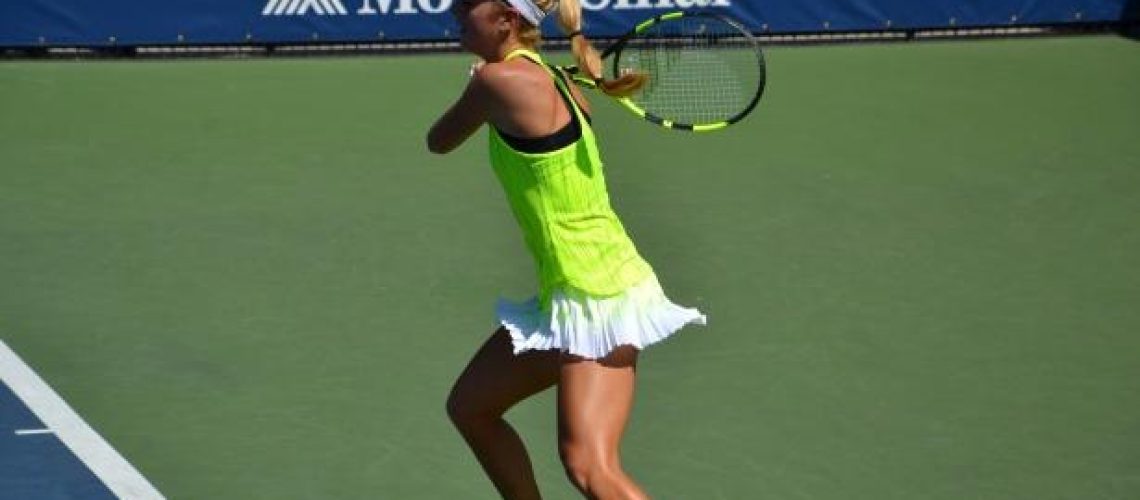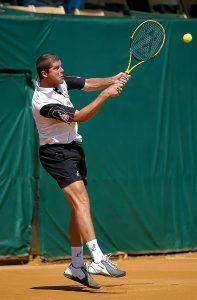We may earn money or products from the companies mentioned in this post.
Understanding the Term “Ad” in Tennis

When it comes to tennis scoring, there are certain terms that can be a bit perplexing for newcomers One such term is “ad” What exactly does it mean? Where did it originate from? Let’s dive into the fascinating world of tennis scoring to uncover the answers
Definition and origin of “ad”
The term “ad” in tennis refers to the advantage gained by a player after a game reaches deuce Deuce occurs when both players or teams have scored three points each, resulting in a tie To break this tie and determine who will win the game, players must gain an advantage
The origin of the term “ad” can be traced back to French, where ad means advantage or benefit In early tennis games, players would use French terms to indicate their position on the court When a player had an advantage after deuce, they would call out “avantage,” which eventually evolved into today’s commonly used term – “ad”
Key roles of tennis scoring terms
-
Deuce:
Deuce is a crucial term in tennis scoring that signifies equality between both players or teams with three points each It acts as a pivotal moment in the game where one more point is needed for either player to gain an advantage and win the game -
Advantage:
After deuce, when one player wins a point, they gain an advantage over their opponent This means they only need one more point to win the game while their opponent needs two consecutive points to regain parity and return to deuce
In summary, understanding the term “ad” in tennis allows us to grasp the significance of gaining an advantage after deuce This scoring system adds excitement and unpredictability to the game, as players strive to secure that all-important point to claim victory So the next time you’re watching a thrilling tennis match, you’ll know exactly what it means when the score reads “ad”
Scoring System in Tennis Matches

Tennis, a sport known for its elegance and precision, has a unique scoring system that adds an extra layer of excitement to the game Understanding the basics of tennis scoring is essential to fully appreciate the thrill and intensity of each match
Basics of Tennis Scoring
In tennis, points are not counted as 1, 2, 3, and so on Instead, a different terminology is used: love (0 points), 15 (1 point), 30 (2 points), and 40 (3 points). This unconventional system brings a touch of whimsy to the sport and keeps spectators on their toes as they follow the score
But why stop at 40? In order to win a game in tennis, players must secure victory by two points So when both players reach a score of 40, it’s called “deuce,” marking an exciting turning point in the match where every point becomes crucial
Tiebreak Situations
In intense matches where games are tightly contested, tiebreak situations often arise These moments test the skill and mental fortitude of players as they strive to outmaneuver their opponents
When faced with deuce occurrences – that nail-biting situation where both players have reached a score of 40 – something special happens Instead of continuing with traditional scoring rules, players enter into what is known as a tiebreak
During a tiebreak, players take turns serving one point each until someone reaches seven points or more with at least a two-point lead over their opponent The first player to achieve this wins the tiebreak and usually gains valuable momentum in the match
Advantage can be gained during tiebreak situations by carefully strategizing and capitalizing on opportunities Each point becomes a critical moment, as players strive to inch closer to victory while preventing their opponents from gaining the upper hand
Understanding the intricacies of the scoring system in tennis adds an extra layer of excitement for fans and players alike The unique points system, the importance of winning by two points, and the intensity of tiebreak situations all contribute to making tennis a truly captivating sport
Strategies for Winning Advantage Points and Ad Court Tactics

When it comes to tennis, understanding your opponent’s weaknesses can give you a significant advantage By recognizing their backhand or forehand flaws, you can exploit those areas to gain the upper hand Is their backhand shaky? Attack it relentlessly with powerful shots to force errors Alternatively, if their forehand is weak, aim your shots towards that side of the court to keep them off balance
In addition to exploiting specific shot weaknesses, targeting weak serves or returns can also help you secure advantage points Pay close attention to how your opponent serves and returns the ball If they struggle with powerful serves or have difficulty returning certain types of shots, capitalize on these weaknesses by placing your shots strategically and forcing them into defensive positions
Adapting to Playing on the Ad Side of the Court
Playing on the ad side of the court requires some adjustments in strategy One key aspect is optimizing serve placement Instead of solely focusing on power, consider targeting specific areas such as wide corners or body shots, making it harder for your opponent to return effectively from that position
To further enhance your performance on the ad side, utilizing angles and depths effectively can be a game-changer Experiment with hitting cross-court shots that go deep into the corner, forcing your opponent to cover more ground and increasing their chances of making errors Mixing up shot selection and varying angles will keep them guessing and off balance
Common Questions & Misconceptions about “Ad” in Tennis

Why is it called an “Advantage” point?
One common question that many tennis enthusiasts have is why the term “advantage” is used to describe a specific point during a game The reason behind this terminology lies in the scoring system of tennis When a game reaches deuce, which means both players have scored three points each, the next point becomes crucial If a player wins that point, they gain the advantage over their opponent This advantage allows them to only need one more point to win the game, while their opponent still needs two consecutive points to secure victory
Relationship between ad-in and ad-out
In tennis, there are two different scenarios where the terms “ad-in” and “ad-out” come into play
-
Explanation of ad-in scenarios:
Ad-in occurs when the serving player has won the first point after deuce At this stage, they have gained an advantage over their opponent and are now serving from the advantageous side of the court (the right side for right-handed players). This positioning gives them a slight edge as they continue their service game -
Explanation of ad-out scenarios:
On the other hand, ad-out refers to when the receiving player wins the first point after deuce In this situation, they have leveled the playing field by equalizing at deuce once again but now have to serve from what’s considered a disadvantageous position on the left side of the court (for right-handed players).
Is there a limit to how many times deuce can occur?
A misconception about tennis scoring is whether there’s a limit to how many times deuce can occur in a game The truth is that theoretically, deuce can continue indefinitely as long as both players keep winning points alternately after reaching 40-40 However, in practice, the likelihood of multiple deuces occurring consecutively is quite rare With each deuce, the pressure and intensity tend to rise, making it more challenging for both players to maintain their focus and execute their shots accurately
Overall, understanding the nuances of “ad” scoring in tennis can enhance your appreciation for the strategic elements of the game By grasping why it’s called an “advantage” point and recognizing the implications of ad-in and ad-out scenarios, you’ll be able to follow matches more closely and engage in insightful discussions about this exciting sport
Useful Links

What Does Ad Mean In Tennis? Comprehensive Guide In 2023
Definition, Examples, and Questions About the Ad Court
Ad & Advantage In Tennis: Everything You Need To Know
What Does ‘Ad’ Mean in Tennis?
What Does AD Mean in Tennis: A Complete Guide
What does AD mean in tennis?
Glossary of tennis terms
Tennis Terms Meanings: The Ultimate List (A to Z)
Love, Ace, Set… All Tennis Terms Explained
Tennis scoring, explained: A guide to understanding the …
The Tennis Scoring System
What Is Ad Court In Tennis? Definition & Meaning On …
What does AD mean in tennis?
Tennis Terms A to Z
What Does Ad Mean in Tennis? Terminology Guide
Tennis Scores – The No-Ad Scoring System
Tennis Scoring 101
Beginners Guide To Tennis
Deuce in tennis – Meaning, use cases and word’s origin






